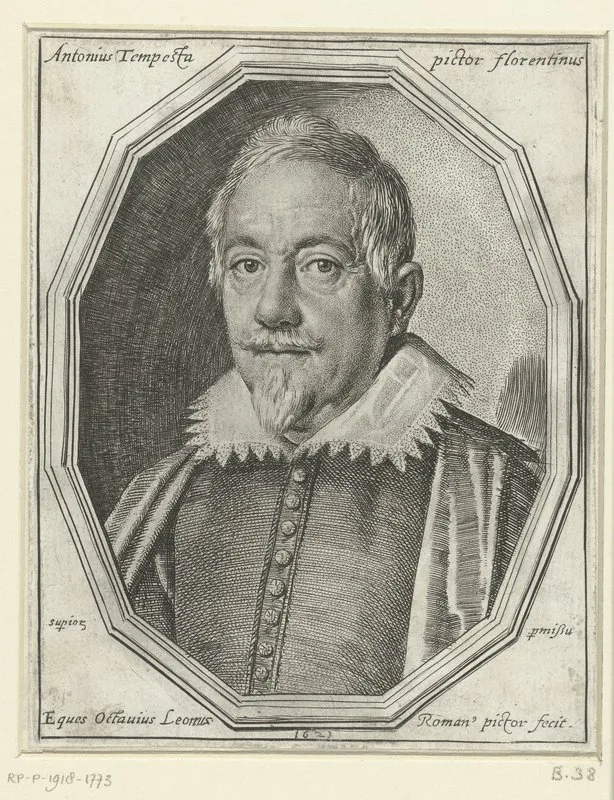
1555–1630
Movements
Occupations
Antonio Tempesta (1555–1630), known as 'Il Tempestino,' was a Florentine painter and printmaker whose extraordinary output of approximately 1,700 etchings made him one of the most influential printmakers of the early Baroque period. Born in Florence and trained under Santi di Tito and the Flemish master Joannes Stradanus, he enrolled in the Accademia del Disegno in 1576 before relocating to Rome in 1580, where he remained until his death. Tempesta served as a crucial artistic bridge between late Mannerism and the Baroque, connecting Florence, Rome, and Antwerp through his widely circulated prints. His prolific work—encompassing biblical narratives, classical mythology, hunting scenes, and battle compositions—provided essential visual references that profoundly influenced subsequent masters including Rembrandt, Rubens, Velázquez, and Poussin. Beyond printmaking, he contributed significant frescoes to papal commissions and pioneered the innovative technique of painting on stone supports.
Born in Florence in 1555, Tempesta received comprehensive training in the vibrant artistic environment of late Renaissance Florence, studying first under Santi di Tito, a leading Counter-Mannerist painter known for clarity and religious devotion
Subsequently trained with the Flemish master Joannes Stradanus (Jan van der Straet), whose international perspective and skill in depicting complex narrative scenes, animals, and hunts profoundly influenced Tempesta's later subject matter and compositional approach
Enrolled in the prestigious Florentine Accademia del Disegno in 1576, joining an elite community of artists and receiving formal instruction in drawing, anatomy, and artistic theory under the institutional framework established by Giorgio Vasari
Participated in major Medici workshop projects at Palazzo Vecchio under Vasari's direction, gaining experience in large-scale fresco painting and collaborative artistic production that characterized late Mannerist court art
Developed foundational skills in both painting and printmaking during this formative period, absorbing the Counter-Mannerist emphasis on narrative clarity and dramatic action that would define his mature style
Relocated to Rome in 1580, establishing himself in the papal capital where he would spend the remainder of his fifty-year career, becoming integral to the artistic community and connecting with Flemish artists working in the city
Received prestigious papal commission from Gregory XIII (with Matthijs Bril) to paint expansive panoramas depicting the Procession to Transfer the Relics of St. Gregory of Nazianzus for the Vatican Palace loggias, demonstrating his skill in large-scale narrative composition
Contributed significant frescoes to the Villa Farnese at Caprarola (1579-1583), particularly the Scala Regia, and collaborated on decorations for Villa d'Este at Tivoli and Villa Lante at Bagnaia, establishing his reputation among elite Roman patrons
Began intensive focus on printmaking through etching and engraving, recognizing the medium's potential for wider dissemination and commercial success, gradually shifting emphasis from fresco painting to print production
Published his monumental Plan of the City of Rome in 1593, an enormous bird's-eye view map assembled from twelve folio-sized etchings measuring 3.5 by 8 feet, demonstrating remarkable cartographic precision and establishing the eastward-oriented view that influenced subsequent Roman mapmakers
Entered his most prolific period of print production, creating vast series that served as visual encyclopedias: 150 plates illustrating Ovid's Metamorphoses, twenty-four plates from the Life of St. Anthony, thirteen plates on the Labours of Hercules, and extensive Old Testament narratives
Produced numerous hunting scene series that became his trademark, including elaborate depictions of courtly hunts featuring boars, lions, and other animals that showcased his mastery of dynamic movement, multiple figures, and dramatic composition
Created extensive battle and cavalcade scenes, including the 1612 'Batavorum cum Romanis Bellum' series (36 plates after Otto van Veen's designs) illustrating conflicts between ancient Dutch tribes and Romans from Tacitus's Histories
Innovatively arranged to have many etchings, including the Metamorphoses series, printed and published in Antwerp rather than Rome, demonstrating entrepreneurial acumen and expanding his European market reach
Developed sequential narrative techniques using illustrated panels with accompanying text, as seen in the 'Life of St. Laurentius' (1599), creating proto-comic book formats that anticipated modern sequential art
Pioneered the innovative technique of painting on unusual stone supports including marble, alabaster, and lapis lazuli, creating highly sought-after works for Roman nobility and international collectors that integrated natural stone veining into landscape compositions
Continued prolific print production while training the next generation, most notably Jacques Callot, the French engraver who would become one of the most influential printmakers of the seventeenth century and transmit Tempesta's techniques forward
Maintained active workshop production until his death on August 5, 1630, at age seventy-five, having created approximately 1,700 etchings that circulated throughout Europe as essential artistic references
Established enduring influence through prints collected and studied by major Baroque masters: Rembrandt owned his works, while Rubens, Velázquez, Poussin, and later artists drew continuous inspiration from his compositional innovations
Left comprehensive visual legacy encompassing biblical narrative, classical mythology, natural history, cartography, and contemporary court life that shaped European Baroque visual culture and remained influential into the eighteenth century
Artheon Research Team
Last updated: 2025-11-28
Biography length: ~2,847 words
Wikidata/Wikimedia Commons